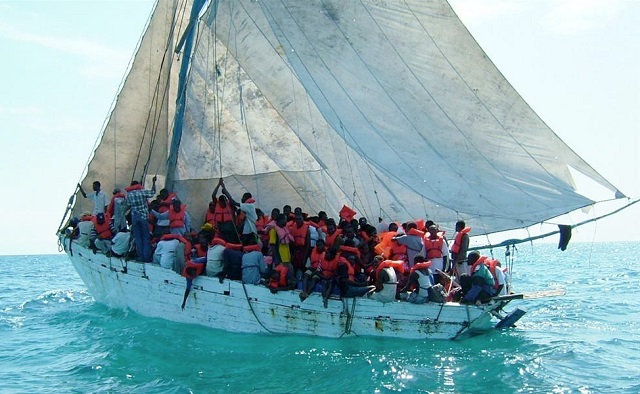225 years of Service: Slaves and Migrants
By Scott Price
The U.S. Coast Guard began its mission of migrant interdiction on the high seas in 1794, when the Congress of the United States declared that no American citizen may carry slaves from the U.S. to another nation or between foreign nations. The Coast Guard, through its predecessor the Revenue Cutter Service, was charged with enforcing this law.
During the next few years, the Revenue Marine, which was later renamed the Revenue Cutter Service, exercised this authority within U.S. coastal waters. In 1799, the Revenue Cutter Governor Jay seized one vessel attempting to transport slaves to Cuba.
Years later, in January 1808, the importation of slaves into the U.S. was declared illegal. Congress charged the Revenue Cutter Service with enforcing the law on the high seas. An example, in 1820, the Revenue Cutter Dallas seized the brig Antelope with 280 slaves aboard.
As the U.S. progressed, so did the immigration laws. In February 1862, Congress prohibited the importation of laborers from China, known as “Coolies,” and forbade U.S. flagged vessels and U.S. citizens from participating in that trade.
From 1794 through 1980 the Coast Guard conducted migrant interdiction only as an adjunct to a primary mission such as search and rescue or though the boarding of a suspicious vessel.
In 1965, Cuban leader Fidel Castro opened the port of Camarioca to anyone who wanted to sail to Cuba to retrieve their relatives. That year, approximately 2,979 Cubans made the voyage to Florida, most assisted by private boats from the U.S.
During this time, the Coast Guard rescued persons in danger and prevented unauthorized vessels from making the hazardous journey. Because of the dangerous nature of the migration, the U.S. government negotiated and organized a series of freedom flights of chartered commercial aircraft with the Cuban government to transport those who wished to leave Cuba safely and efficiently. The flights lasted until 1971 and transported 260,561 men, women and children to the U.S. These operations reduced the risk for both the migrants and those charged with enforcing immigration laws.
The Mariel Boatlift, the U.S.’s first major mass migration by sea, began April 22, 1980, when the Cuban government opened the port of Mariel and permitted refugees to depart Cuba. Thousands of private craft participated in what was the largest mass migration event by sea to that time. More than 124,000 Cubans made it safely to the U.S. The Coast Guard saw extensive service during the event, carrying out more than 1,300 search and rescue missions.
In 1994, the Coast Guard responded to two mass migrations at the same time; first from Haiti, then from Cuba. More than 63,000 migrants were rescued and prevented from illegally entering the U.S. in operations Able Manner and Able Vigil. At its height, operation Able Manner involved 17 Coast Guard cutters, patrolling the coast of Haiti while Operation Able Vigil involved 38 Coast Guard cutters patrolling the Straits of Florida.
One-hundred and sixty-two Haitians on a 42-foot sail freighter were intercepted after being at sea for 10 days by Coast Guard cutters Confidence and Metompkin. The Haitians were transferred to the cutter Confidence just south of the Great Bahamas Bank near Cape Lobos Light.
In 1999 and 2000, Coast Guard cutters on counter-drug patrol in the Eastern Pacific have encountered increasing numbers of migrants being smuggled from Ecuador to points in Central America and Mexico. While this may not have a direct connection to the U.S., the Coast Guard acts for humanitarian reasons. Most of these vessels do not have the proper conditions to transport these migrants and lack the safety equipment in the event of an emergency. The Coast Guard works with the flag state of the vessels and other countries to escort the vessels to the closest safe port.
Undocumented migrants continue to pose a threat to the U.S. today. While the primary threat comes from Haiti, the Dominican Republic, the People’s Republic of China, and Cuba, the Coast Guard has interdicted migrants of various nationalities throughout the world.
Holding true to its motto, the Coast Guard stands Semper Paratus for migrant interdiction operations.

The opinions expressed herein are the author's and not necessarily those of The Maritime Executive.
